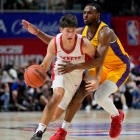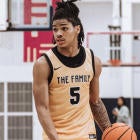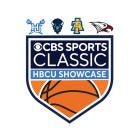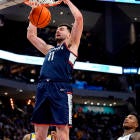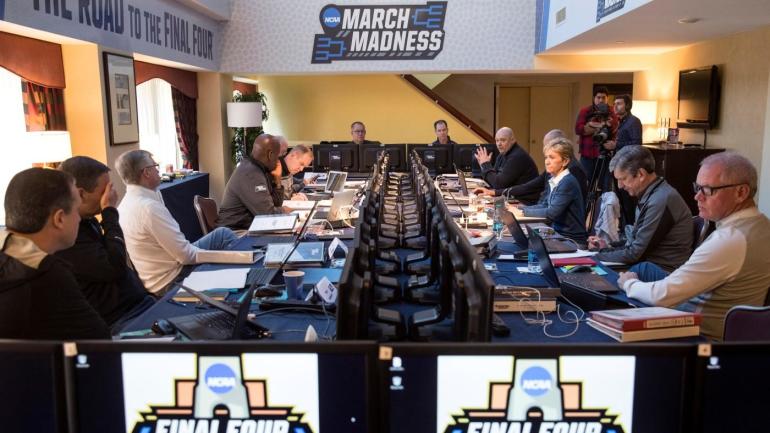
Every February since 2017, men's college basketball gets a one-time-only peek behind the curtain to see what the NCAA Division I men's basketball selection committee thinks about the best teams before we get to Selection Sunday.
That time comes again on Saturday, when CBS will air its annual in-season bracket of the 16 top teams according to the selection committee on the NCAA March Madness Men's Bracket Preview. The show will begin at 12:30 p.m. ET. When we see all the No. 1, 2, 3 and 4 seeds unsheathed, we will be 22 days from Selection Sunday. Normally, this show happens 29 days from Selection Sunday, but as committee chair Tom Burnett told CBS Sports this week, with the NFL extending its season by one week, all parties thought it best to wait until after the Super Bowl to do this.
Will this be a permanent change to the college hoops calendar?
"We're not quite sure yet what the future holds, that will certainly be for the committee moving forward after I depart," Burnett, who is in his final season on the committee, told CBS Sports. "Three weeks is close, but we've got a lot of basketball left. I believe the count is near 750 games remaining in the regular season, and then we've got all the conference tournaments. So, a lot can change even if it's just three weeks."
That's true, but the short history of this in-season bracket teaser has also proved informative with some accurate foreshadowing. The previous four times there has been an early reveal that later had an NCAA Tournament (2017-19, 2021), three of the four No. 1 seeds in February held the top line in March. (While there was no 2020 NCAA Tournament, the projections that year also kept this pattern.) Last year, Gonzaga, Baylor and Michigan held, while Ohio State dipped down to No. 2 come Selection Sunday.
Additionally, the four previous times the NCAA has done this (not accounting for 2020 when there was no tournament), one of the the four No. 1 seeds from February went on to win the national title.
2017
Early No. 1 seeds: Villanova, Kansas, Baylor and Gonzaga.
Actual No. 1 seeds: Villanova, Kansas, Gonzaga and North Carolina.
National champion: North Carolina
2018
Early No. 1 seeds: Virginia, Villanova, Xavier and Purdue
Actual No. 1 seeds: Virginia, Villanova, Xavier and Kansas
National champion: Villanova
2019
Early No. 1 seeds: Duke, Virginia, Tennessee and Gonzaga
Actual No. 1 seeds: Duke, Virginia, Gonzaga and North Carolina
National champion: Virginia
2020
Early No. 1 projected seeds: Baylor, Kansas, Gonzaga and San Diego State
Actual No. 1 seeds: No tournament (Baylor, Kansas and Gonzaga were projected No. 1s)
National champion: No tournament
2021
Early No. 1 projected seeds: Gonzaga, Baylor, Michigan and Ohio State
Actual No. 1 seeds: Gonzaga, Baylor, Michigan and Illinois
National champion: Baylor
CBS Sports Bracketology Expert Jerry Palm projects Auburn, Gonzaga, Arizona and Kansas to be on the four top lines of the bracket. So, this is good news for fans of those programs. Because we are one week closer than usual to Selection Sunday for this show, the chances at least three of those teams maintain their elite seeding is even better.
"As we've gotten into conference play, we've had some results, teams are not going to be perfect they're going to lose games and such and take that into account and, again, remember the entire body of work," Burnett said.
The committee considered "six to seven programs" for the No. 1 seeds, and Burnett said contingencies were in place for Thursday night and Friday night results to adjust the bracket if necessary. (The committee met in person this week in Indianapolis and concluded their meetings on Thursday afternoon. For a refresher on seeding and bracketing principles, read this.) Overall, Burnett said "20 or so" teams were considered for the top 16 lines and it took three seed scrubs to get there.
This is the fourth season of the NCAA's NET rankings, which replaced the RPI (now a defunct/extinct metric, per the NCAA). As college hoops fans know, the NET has become the primary metric referenced across college hoops. But is it too emphasized by the media? Burnett said yes.
"It allows the committee to certainly maybe not make all of our decisions, but based some of the things we do on that," Burnett said of the NET. "On the team sheet we're looking at KenPom, we're looking at BPI, we're looking at everything that might be out there. And then, we're reading everything. ... I'm seeing what other voices talk about [in] our sport. We're taking all of that in, and certainly the NET plays a role in what we do as a committee, but it's not everything. And I will tell you certainly there's no circumstances where NET wins the day. NET makes us look at other things. That's my experience in the committee room. Why is their NET so high? Why are they so good in the predictives vs. the results metrics?"
It's an important distinction, as the committee has six metrics on team sheets it refers to. Four of those metrics are predictive in nature: NET, KenPom.com, Jeff Sagarin's ratings and ESPN's BPI. The two others — Strength of Record and the Kevin Pauga Index; KPI for short — are strictly résumé-based and are not influenced by team efficiency, scoring margin or any predictive qualities. Burnett emphasized how crucial all of these data points are to committee members now.
The eye test is not nearly as influential in discussion as it once was, according to Burnett.
"We're talking about the full body of work," he said. "Anything starting in November all the way through the conference tournaments, and that will factor in to what we do. But there's a lot of conversation about why metrics shape up the way they do, what does this number mean, and we may not get to all the final answers, but it's certainly a big part of the conversation.
"I think that's what our membership wanted us to do a few years ago was to bring that discussion more into the committee room, get away from what's used to be known as the eye test and just looking at someone and saying, 'They're a good team,' or 'maybe they're not a good team. They're in the bracket, they're not in the bracket.' We certainly don't want to do that. We want to be able to back up the information we share and reveal, whether it's this weekend or it's the real thing in three weeks."
One significant change with this year's committee is its expansion from 10 to 12 people. For more than five decades the NCAA selection committee in men's basketball had only 10 representatives. Two more were added in an effort to diversify the panel, though the NCAA still is only anointing conference commissioners and athletic directors to the committee. No former coaches or analytic experts or media members or anyone from different walks of life has been considered yet. Can that change? Will it?
"Our committee has a say in kind of how we're formulated but we don't make up our own rules," Burnett said. "There's a nominating committee in the Division I structure, certainly there's a Board of Directors that has final oversight of things. There are other voices that get involved, and when you get a mandate from the Board of Directors down ... I don't know that the basketball committee talked a whole lot about outside voices coming into the committee room, but again, at the end of the day we're not quite sure that's our decision."
Burnett said the committee continues to hear from coaches on this issue, but added that the committee isn't at that point where they're interested in diversifying further.
"So far there's been some comfort in how the committee's are structured," Burnett said.
It might be best to find some discomfort and continue to update how the committee forms its brain trust. The College Football Playoff committee — and its powers-that-be, who are vulnerable to many criticisms — at least hasn't pigeonholed itself to only having ADs and commissioners on its roster.
As for the games and the operations of this year's men's tournament, CBS Sports recently talked with NCAA senior vice president of basketball Dan Gavitt, who said, "We've gone back to the original playbook. This year's tournament is being planned and executed like it was pre-pandemic. And that's not to say that we're not looking at adjustments that need to be made. We certainly are."
Said Burnett: "What's different this year is really an effort to get the tournament back on track, get it back to its course of 14 different sites, starting in Dayton. ... We've got the policies and procedures in place, we know how to put tournament together. We know how to get people excited, or maybe angry at us, for the matchups and all of that that are ahead. ... Putting it back on course at the sites that we know it to be at is the main focus here and I think we're getting close to getting that accomplished."
The NCAA Tournament is scheduled to get underway on the men's side on March 15 in Dayton, Ohio. Selection Sunday is March 13.










